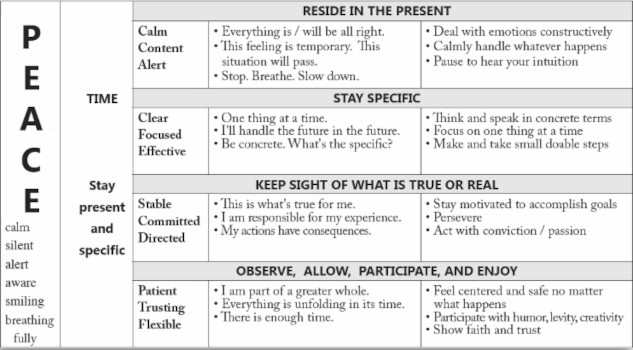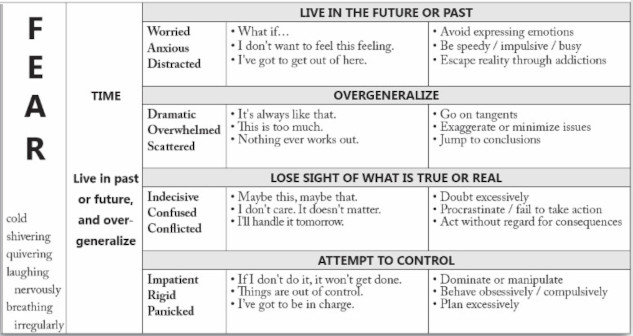
Image by Ri Butov
In This Article:
- The core attitudes associated with peace.
- How you can calm your mind and feel peace.
- The relationship between peace and fear?
- Five simple strategies to experience more peace daily.
- How shivering can reduce fear and promote peace.
Peace is Right Around the Corner: Five Ways That Work
by Jude Bijou.
Peace is one of human's six emotions. It's the opposite of fear. When we're experiencing peace, we're relaxed, content, and our mind is still. It’s often thought that we need to meditate in order to feel peace, but it's not true. If we pacify our fear, peace will naturally arise.
According to Attitude Reconstruction, this is a summary of the four core attitudes, including the feelings, thoughts, and actions, that are associated with the emotion of peace. When we experience peace our attention is fully in the present, and we observe, allow, participate, and enjoy the now.
Just look at the feelings associated with peace. Who doesn’t want to feel calm, alert, clear, focused, directed, patient, flexible, and trusting? These are some of the feelings encompassed in a peaceful state.

About Fear
Conversely, people whose most dominant emotion is fear are easy to recognize. In general, these are the "speedy ones," usually physically slim and focused on time and money. They are often agitated, nervous, and anxious. Mentally, they feel that there's never enough. They are usually focused in the future and speak about the past by making huge over-generalizations. They tend to be worriers - scattered, confused, overwhelmed, dramatic, panicky, or controlling. If you ask them, they will tell you that peace is something that's desirable but ultimately elusive.
Below are the four core attitudes associated with fear, as laid out on the Attitude Reconstruction Blueprint.

Since "peace" is the opposite of "fear" it makes sense that if we deal with the fear, peace will be nearby.
Five Doable Ways to Feel More Peace
Here are five strategies to increase peace (and decrease fear), according to Attitude Reconstruction.
1. Shiver the fear out of your body rather than tightening up.
Shivering, trembling, shaking, and shuddering is a simple but amazingly effective strategy to move the agitation in your body and mind. Emotions are just pure physical sensations in your body. Allow yourself to physically express the fear you feel rather than tightening up and stop breathing.
When I feel nervous, jumpy, agitated, or my mind is racing a million miles an hour, I let my body do what's natural. I vigorously shiver, shudder, and shake all over, like a dog at the veterinarian or a person who has just witnessed a horrifying event. Though it can seem weird, silly, or contrived at first to jiggle, shiver, tremble, and let my knees knock, I almost immediately feel more relaxed, centered, and able to focus.
When I can't sleep at night, need to return a scary telephone call, or worry about making a presentation, I duck into the bathroom, shiver for just a minute or two, and remind myself: " It's okay to feel scared. I just need to shiver." The result is almost miraculous. This one simple activity restores calm and brings me back to the present. Give it a try!
Here is a video that demonstrates shivering.
2. Interrupt thoughts about the future and past, and avoid over-generalizations.
If you are a worrier or often feel overwhelmed, you have unexpressed fear. To keep things manageable and in perspective, keep bringing yourself back to the present. And be specific about the concerns at hand, rather than generalizing about your whole life, your relationship history, your character, the world, and so on.
The words "always" and "never" fuel fear. Likewise, bringing other unresolved issues into the specific topic you're grappling with is like putting gasoline on the barbecue. It makes reaching a satisfactory resolution or clear thinking nearly impossible.
I highly recommend that, over and over, you tell yourself reassuring things. Many times a day, repeat whichever of these phrases will be most calming: "Stay specific. I'll handle the future in the future. Everything will be all right. Everything is all right. One thing at a time. Everything is unfolding in its own time. Be here now.”
3. Accept what is.
Spending time wishing things were different or judging people negatively when they don’t conform to your views keeps you in a cycle of nonacceptance and agitation. Rather than complaining or turning a blind eye to what bugs you, practice accepting the reality that the world does not revolve around you. When you truly accept a situation, you are free to be creative and determine what, if anything, you can or need to do.
4. Break big projects into a series of simple little steps, and attend to one thing at a time.
The key to managing fear and life's tasks is to take the time daily to get organized. For each task you need to accomplish, start by articulating your goal. With that in mind, break each task into a series of little doable increments. Make each step small enough so you know you can do it.
If you keep an ongoing list of exactly what needs to be done by when, you can evaluate what's most important and essential for today. I put my to-do list in an obvious place by my computer so I can see it. Then I just do what's next and offer myself copious praise for each small victory.
5. In terms of lifestyle choices, strive to establish a regular, more relaxing routine.
Cut down on the coffee, coke, and energy drinks. Stay out of cold, damp, and drafty places. Reduce the amount of stimulation you expose yourself to, especially at night. Get more sleep. Don't miss meals.
You'll feel better if you spend time engaging in less frightening or anxiety-producing activities, situations, movies, or games, and more time doing relaxing things, such as gentle walks, watching sunsets, and listening to calming music.
Final Thoughts
By following just a few of these simple suggestions - taking little baby steps and shivering whenever agitation comes knocking - I'm certain you'll soon find that you enjoy whatever your day brings. You'll be able participate with more humor, ease, and equanimity, and feel more peace!
©2024 by Jude Bijou, M.A., M.F.T.
All Rights Reserved.
Book by this Author: Attitude Reconstruction
Attitude Reconstruction: A Blueprint for Building a Better Life
by Jude Bijou, M.A., M.F.T.
 With practical tools and real-life examples, this book can help you stop settling for sadness, anger, and fear, and infuse your life with joy, love, and peace. Jude Bijou's comprehensive blueprint will teach you to: ? cope with family members' unsolicited advice, cure indecision with your intuition, deal with fear by expressing it physically, create closeness by truly talking and listening, improve your social life, increase staff morale in just five minutes a day, handle sarcasm by visualizing it flying by, carve out more time for yourself by clarifying your priorities, ask for a raise and get it, stop fighting via two easy steps, cure kids' tantrums constructively. You can integrate Attitude Reconstruction into your daily routine, regardless of your spiritual path, cultural background, age, or education.
With practical tools and real-life examples, this book can help you stop settling for sadness, anger, and fear, and infuse your life with joy, love, and peace. Jude Bijou's comprehensive blueprint will teach you to: ? cope with family members' unsolicited advice, cure indecision with your intuition, deal with fear by expressing it physically, create closeness by truly talking and listening, improve your social life, increase staff morale in just five minutes a day, handle sarcasm by visualizing it flying by, carve out more time for yourself by clarifying your priorities, ask for a raise and get it, stop fighting via two easy steps, cure kids' tantrums constructively. You can integrate Attitude Reconstruction into your daily routine, regardless of your spiritual path, cultural background, age, or education.
For more info and/or to order this book, click here. Also available as a Kindle edition.
About the Author

Jude Bijou is a licensed marriage and family therapist (MFT), an educator in Santa Barbara, California and the author of Attitude Reconstruction: A Blueprint for Building a Better Life.
In 1982, Jude launched a private psychotherapy practice and started working with individuals, couples, and groups. She also began teaching communication courses through Santa Barbara City College Adult Education. Visit her website at AttitudeReconstruction.com/
Article Recap:
The article explores the relationship between peace and fear, offering practical methods to increase peace in daily life. It introduces five simple strategies, such as shivering to release fear, staying present, and accepting reality. The piece emphasizes that peace naturally arises when fear is managed and provides easy, actionable steps to bring calm and focus into everyday situations.




























